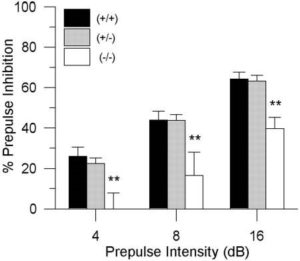DAT KO mice are characterized foremost as an animal model ADHD (attention deficit hyperactivity disorder. These animals display a reduced level of dopamine primarily in the cortex, akin to ADHD patients, that is reversed by the use of psychostimulants such as dextro- amphetamine and methylphenidate. These animals also exhibit ADHD like behavioral phenotypes such as hyperactivity, disrupted sensorimotor gating and increased impulsivity, that are reversed by dextro-amphetamine and methylphenidate. Some of the behavioral phenotypes of these mice (such as disrupted PPI and memory deficits) may also render them as a model of schizophrenia or bipolar disorder.
(-/-)= Mice heterozygous to DAT knockout mutation, (+/-)= Mice heterozygous to that mutation, (+/+)= WT mice.
Ralph RJ et al 2001. Journal of Neuroscience 21(1): 305-313. Copyright (2001) Society for Neuroscience.
Effect of DAT knockout on sensorimotor gating as demonstrated in the prepulse inhibition paradigm. Mice homozygous to the DAT KO mutation show decreased PPI to various prepulse levels (X axis shows different prepulse intensity in dB above background noise levels) compared to mice heterozygous for that mutation and WT mice.
References
Efimova EV, Gainetdinov RR, Budygin EA, Sotnikova TD. Dopamine Transporter Mutant Animals: A Translational Perspective (2016). Journal of Neurogenetics . 30(1):5-15.
Ralph RJ, Paulus MP, Fumagalli F, Caron MG, Geyer MA (2001). Prepulse Inhibition Deficits and Perseverative Motor Patterns in Dopamine Transporter Knock-Out Mice: Differential Effects of D1 and D2 Receptor Antagonists. The Journal of Neuroscience. 21(1):305-13.

